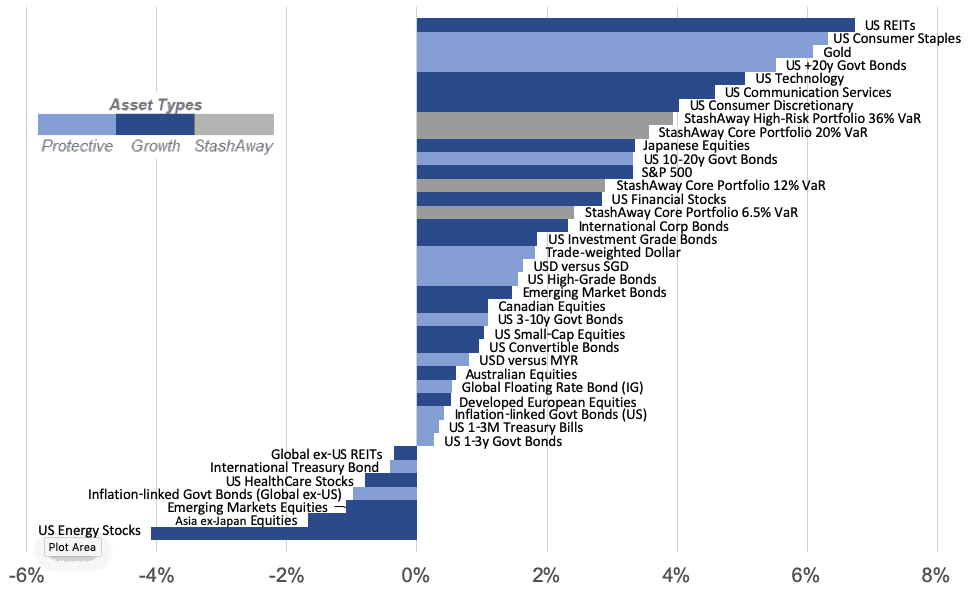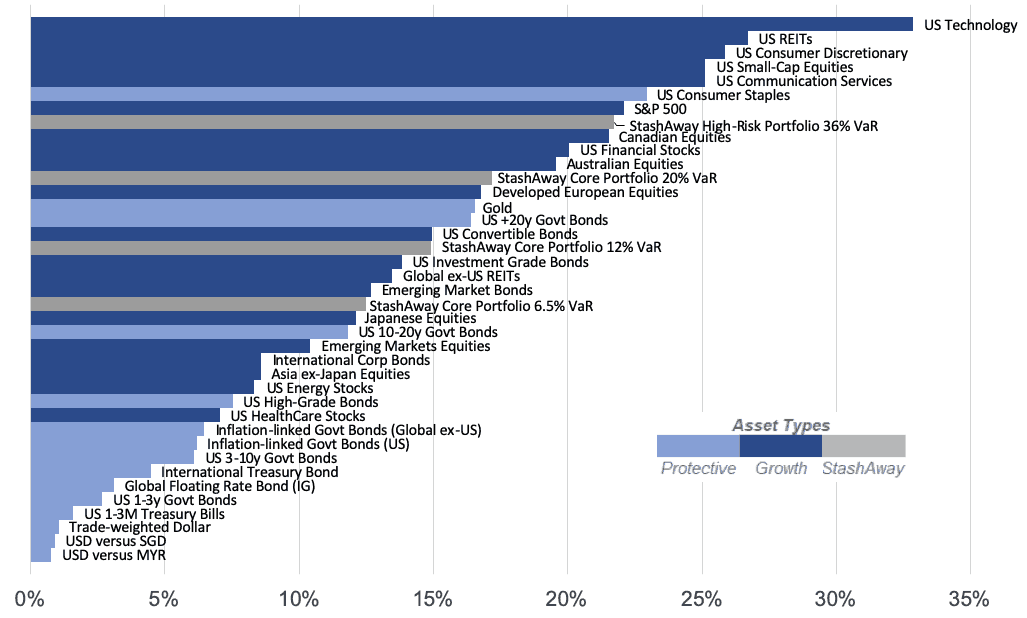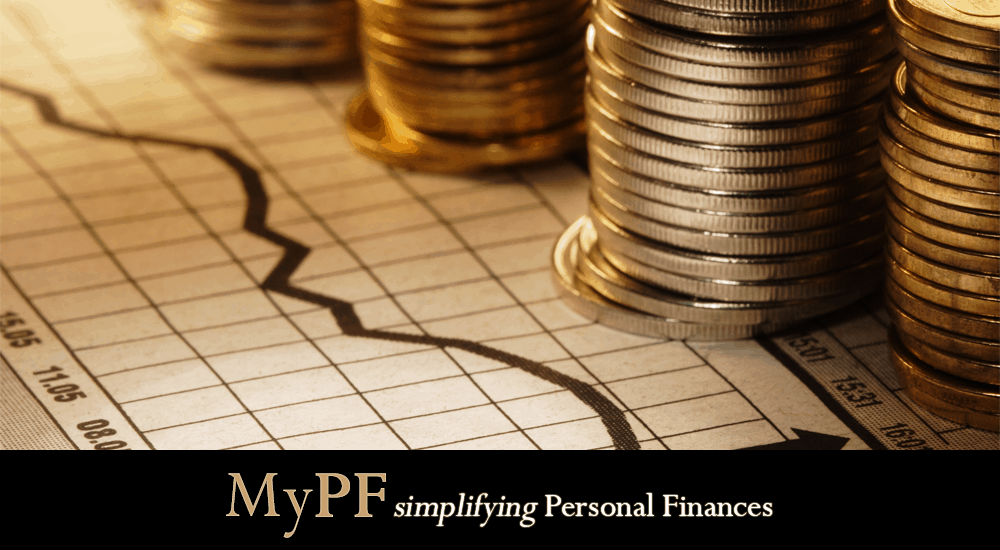The same stories keep replaying. The first 2 months of Q3 2019 were once again besieged by random flip flops in the US-China trade negotiation, the media continue to misinterpret the yield curve, and US and UK political dramas ensue. The original version of this article was published on StashAway.my.
This month, it appeared that China may not care to negotiate with the Trump administration anymore, and so President Trump predictably started to cave in. And, once again, the media misinterpret the flat to inverted yield curve as a symbol of an impending recession, blindly keeping the market on its toes. Then, the markets found solace with the firing of John Bolton, Trump’s hardliner on foreign policy, and the humiliating series of defeats by Boris Johnson in the UK. Though the stock markets rebounded in September, they only masked the hardships investors had to endure to get here. Sounds like January 2018, October 2018, December 2018…
Somehow, these familiar bumps still seem to hurt just as much as ever. Enter, the recency effect. The recency effect occurs when we remember more recent information better, thus giving that information more weight when forming a judgment than we do to events that happened longer ago.To achieve investing success over the long term, we need to focus on systematic decisions that eliminate any chance of the recency effect interfering with our investment’s trajectories. Half of the battle is won by the way portfolios are constructed. That’s why we build resilience into our portfolios in a way that withstands market noise and human emotion. The other half of the battle is won when we each stick to a systematic investment plan that helps us defeat the possibility of letting the recency effect cloud our decision-making.
Contents
Not all diversification is created equal
StashAway’s ERAA® builds resilience into your portfolios by focusing on high quality signals based on holistic economic data. Stashway is also focused on delivering calculated diversification for your portfolios. A recent example of how Stashaway continually enhances portfolios’ diversification strategy was last month when Stashaway expanded the number of investable assets that ERAA® uses to build portfolios, from 19 to 32. This substantially expanded the geographies and asset differentiation that ERAA® can source going forward.
Take a look at how Stashaway’s asset class universe has performed in the last quarter as well as YTD:
Figure 1 – Quarter-to-Date Asset Class Total Returns (Total Returns in USD, As Of 12 Sep 2019)
(Source: StashAway, Bloomberg)
Figure 1 shows quarter-to-date performances across the asset classes in the ERAA® universe. As can be observed in Q3 performance numbers, protective assets have generally performed better than growth-oriented ones, with the exception of US REITs, which benefited from a continuation of low interest rates. US consumer staples and Gold were the top protective asset class performers. The worst performers in Q3 were Singapore equities, US energy stocks, Singapore REITs, and the Asia ex-Japan region, all losing between 1.7% to 5.2% in the quarter. Regardless of risk levels, StashAway portfolios have demonstrated resilience throughout the quarter, gaining 2.4% to 3.9% in total returns before fees, respectively.
On a year to date basis (as of 12 September), the risk-focused approach has seen ERAA® navigate the ups and downs of markets well. As shown in Figure 2, depending on your risk levels, StashAway portfolios delivered between 12.5% and 21.7% in USD-denominated total returns before fees.
Figure 2 – Year-to-Date Asset Class Total Returns (Total Returns in USD, As Of 12 Sep 2019)
(Source: StashAway, Bloomberg)
StashAway’s ERAA® keeps your investments resilient by systematically making adjustments to asset class expected return and risk whenever the valuations are distorted beyond a specific threshold. The first valuation adjustment ERAA® made was in December 2017, when it increased Gold allocations and consumer staples equities. To this day, ERAA® has maintained this Gold allocation.
In mid-August 2019, ERAA® made another valuation adjustment; this time, ERAA® made a contrarian call to raise the expected returns for European equities. In this market, the markets were pessimistic about equity pricing compared to what economic data indicate. Specifically, ERAA® acknowledges the widening gap between the dividend yield of EuroStoxx vis-a-vis that of European sovereign bond yields. This systematic approach is medium-term in nature and helps prevent FOMO (“fear of missing out” when valuations are high) and FOF (“fight or flight” response when valuations are low).
A note since Stashaway’s re-optimisation on 15 August
On 15 August, Stashaway re-optimised their portfolios to reflect the latest economic conditions and valuation gaps of asset classes around the world. In essence, ERAA® made the following key changes during the re-optimisation:
- As the global economy confronts greater economic uncertainty than the US, ERAA® has adopted a more conservative “All-Weather Strategy” for non-US assets, while maintaining a growth stance for US assets.
- ERAA® shifted from US-centric bond holdings to a globally diversified alternative.
- In view of “flat” to inverted yield curves, ERAA® shortened the average bond maturity of its holdings from 13.5 years to 7.9 years.
- ERAA® made its second contrarian call since mid-Dec 2017 and allocated to European equities on the back of cheap valuation vs economic factors.
The success of your investments also relies on investor behavior
Again, half the battle is on Stashaway making sure their investment strategy is sound. The other half is making sure you stick to your investment plan. No matter how well asset classes perform in the medium to long term, if you’re only investing periodically, you’re exposing your money to unnecessary short-term fluctuations: Geopolitical issues won’t dissipate, media won’t stop making noise, and markets won’t stop reacting day in and day out.
To protect your money (and sanity), tune out the noise that both traditional and social media blast. A better way to stay in control of your money is simply to take some “me time” to review your investment plan on a periodic basis. Whether you check in quarterly, semi-annually, or annually is up to you; the most important thing is that you keep yourself accountable and make sure you’re sticking to these 4 keys to build and maintain your long-term wealth.
- Have your cash buffer: Do you have at least 6 to 12 months of living expenses in a safe, liquid asset (e.g. a saving account)?
- Avoid leverage: Don’t borrow to grow funds you can’t afford to lose. So, avoid margin trading accounts.
- Stick to a systematic plan: Are you saving money and investing these savings regularly (eg every month)?
- Take appropriate risk: “High-risk, high-return” only applies with medium-to-long-term time horizons. If you’re losing sleep over how your investments are doing, you’re taking more risk than you should. The longer your timeline, the more risk you can take, and that’s because you have more time to recover from short-term drawdowns.
Notice that these keys to long-term investing success don’t rely on timing or beating the markets. Intelligent investing isn’t difficult investing.
Signup for Stashaway
Account opening link: Stashaway.my
Exclusive MyPF x StashAway signup promotion with 100% fees waived! No minimum investment amount needed for initial signup.
You May Also Like
- How to StashAway
- Introducing Malaysia’s First Robo Advisory, StashAway
- StashAway’s ERAA® (Economic Regime-based Asset Allocation) (stashaway.my)
- Stashaway: Introducing New Asset Classes and Geographies
- StashAway x MyPF Promo
Share your thoughts with us in the comments below.






Leave A Comment